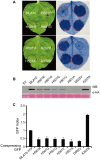Structure-function analysis of barley NLR immune receptor MLA10 reveals its cell compartment specific activity in cell death and disease resistance
- PMID: 22685408
- PMCID: PMC3369952
- DOI: 10.1371/journal.ppat.1002752
Structure-function analysis of barley NLR immune receptor MLA10 reveals its cell compartment specific activity in cell death and disease resistance
Abstract
Plant intracellular immune receptors comprise a large number of multi-domain proteins resembling animal NOD-like receptors (NLRs). Plant NLRs typically recognize isolate-specific pathogen-derived effectors, encoded by avirulence (AVR) genes, and trigger defense responses often associated with localized host cell death. The barley MLA gene is polymorphic in nature and encodes NLRs of the coiled-coil (CC)-NB-LRR type that each detects a cognate isolate-specific effector of the barley powdery mildew fungus. We report the systematic analyses of MLA10 activity in disease resistance and cell death signaling in barley and Nicotiana benthamiana. MLA10 CC domain-triggered cell death is regulated by highly conserved motifs in the CC and the NB-ARC domains and by the C-terminal LRR of the receptor. Enforced MLA10 subcellular localization, by tagging with a nuclear localization sequence (NLS) or a nuclear export sequence (NES), shows that MLA10 activity in cell death signaling is suppressed in the nucleus but enhanced in the cytoplasm. By contrast, nuclear localized MLA10 is sufficient to mediate disease resistance against powdery mildew fungus. MLA10 retention in the cytoplasm was achieved through attachment of a glucocorticoid receptor hormone-binding domain (GR), by which we reinforced the role of cytoplasmic MLA10 in cell death signaling. Together with our data showing an essential and sufficient nuclear MLA10 activity in disease resistance, this suggests a bifurcation of MLA10-triggered cell death and disease resistance signaling in a compartment-dependent manner.
Conflict of interest statement
The authors have declared that no competing interests exist.
Figures






References
-
- Jones JD, Dangl JL. The plant immune system. Nature. 2006;444:323–329. - PubMed
-
- Dodds PN, Rathjen JP. Plant immunity: towards an integrated view of plant-pathogen interactions. Nat Rev Genet. 2010;11:539–548. - PubMed
-
- Maekawa T, Kufer TA, Schulze-Lefert P. NLR functions in plant and animal immune systems: so far and yet so close. Nat Immunol. 2011;12:817–826. - PubMed
-
- Shirasu K, Schulze-Lefert P. Regulators of cell death in disease resistance. Plant Mol Biol. 2000;44:371–385. - PubMed
Publication types
MeSH terms
Substances
LinkOut - more resources
Full Text Sources
Other Literature Sources

